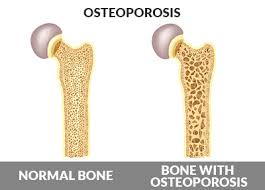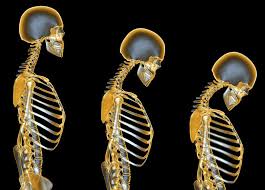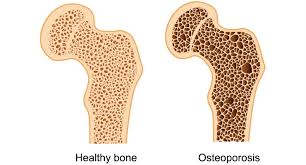Bone is living tissue that is constantly being broken down and replaced. Osteoporosis occurs when the creation of new bone doesn’t keep up with the removal of old bone.
Osteoporosis is a bone disease. Its name comes from Latin for “porous bones.”

The inside of a healthy bone has small spaces, like a honeycomb. Osteoporosis increases the size of these spaces, causing the bone to lose strength and density. In addition, the outside of the bone grows weaker and thinner.The bones become weaker, increasing the risk of fractures, especially in the hip, spinal vertebrae, and wrist.
Symptoms:
In early stages ,there are no symptoms of bone loss. But once your bones have been weakened by osteoporosis, you may have signs and symptoms that include:
- Back pain
- Loss of height over time
- A stooped posture
- A bone fracture that occurs much more easily than expected

Risk factors:
The biggest risk factors for osteoporosis include:
- being female
- being an older adult
- being Caucasian or Asian
- having a family history of osteoporosis
- poor nutrition
- physical inactivity
- smoking
- taking certain medications
- Low body weight
- Small-boned frame
Dietary factors:
Osteoporosis is more likely to occur in people who have:
- Low calcium intake. A lifelong lack of calcium plays a role in the development of osteoporosis. Low calcium intake contributes to diminished bone density, early bone loss and an increased risk of fractures.
- Eating disorders. Severely restricting food intake and being underweight weakens bone in both men and women.
- Gastrointestinal surgery. Surgery to reduce the size of your stomach or to remove part of the intestine limits the amount of surface area available to absorb nutrients, including calcium.
Conditions that increase the risk include:
- cancer
- COPD
- chronic kidney disease
- some autoimmune diseases, such as rheumatoid arthritis and ankylosing spondylitis
Medications that raise the risk include:
- glucocorticoids and corticosteroids, including prednisone and prednisolone
- thyroid hormone
- anticoagulants and blood-thinners, including heparin and warfarin
- protein-pump inhibitors (PPIs) and other antacids that adversely affect mineral status
- Some antidepressant medications
- Some vitamin A (retinoid) medications
- Thiazide diuretics
- Thiazolidinediones, used to treat type 2 diabetes, as these decrease bone formation
- Some immunosuppressant agents, such as cyclosporine, which increase both bone resorption and formation
- Aromatase inhibitors and other treatments that deplete sex hormones, such as anastrozole, or Arimidex
- Some chemotherapeutic agents, including letrozole (Femara), used to treat breast cancer, and leuprorelin (Lupron) for prostate cancer and other conditions






